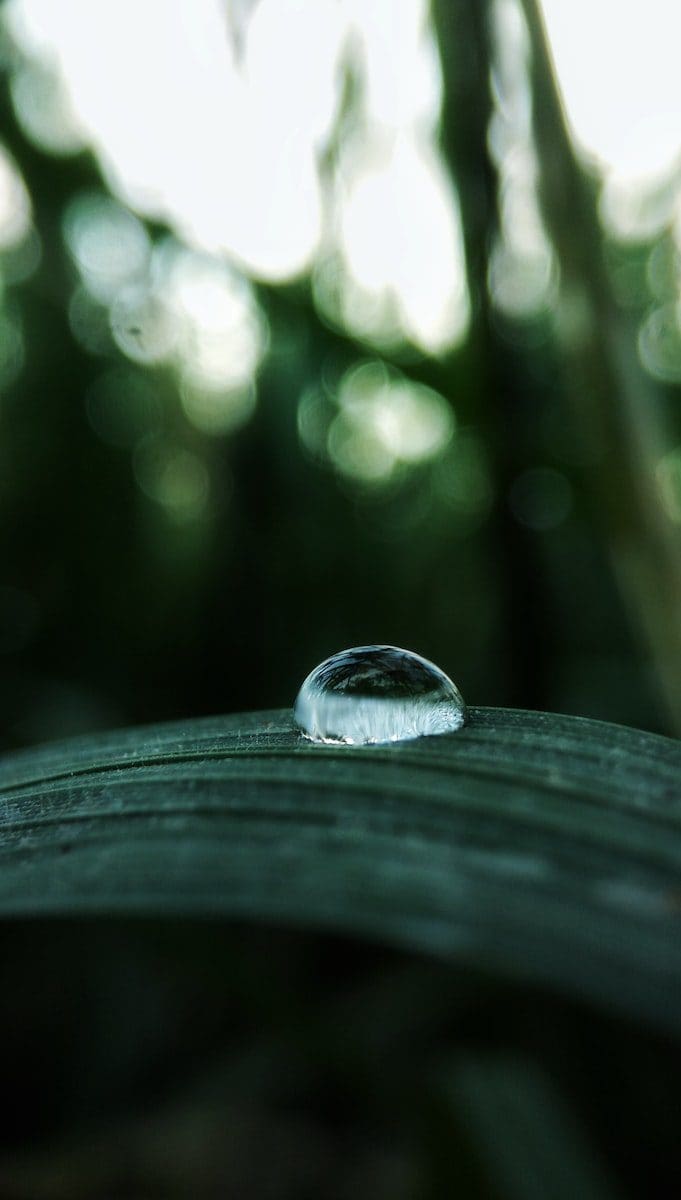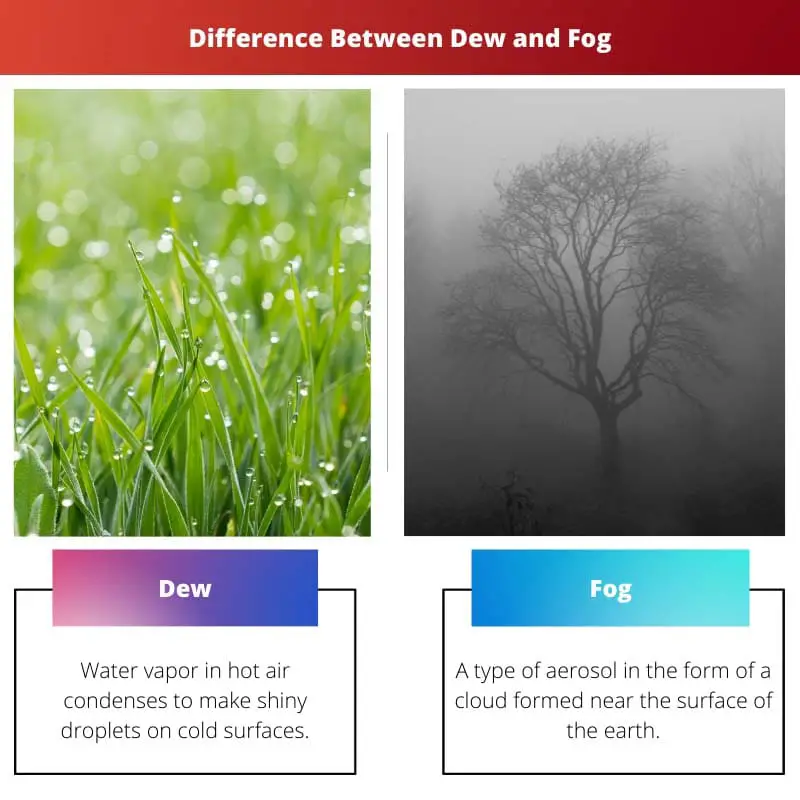Dew is an atmospheric condition where water condenses in the form of water droplets on an exposed object in the morning or evening. It can be seen as lustrous drops on the surface of leaves, grass, and other objects during wintertime.
Fog, on the contrary, is a bulky cloud encapsulating water droplets or ice crystals suspended in the air or close to the surface of the earth.
Key Takeaways
- Dew is formed by condensing water vapor on cool surfaces, whereas the suspension of water droplets in the air forms fog.
- Dew is more likely to form on clear, cool nights with low wind, while the fog is more likely to form on humid days with high humidity.
- Dew is seen on surfaces like grass, leaves, and cars, while fog can be seen in the air and can reduce visibility for drivers.
Dew vs Fog
Dew is moisture that is formed at night when the heat outside cools down, and it is mostly formed on metal surfaces and in any season. Fog is a low-lying cloud of water droplets that is found at low heights, and it is a cloud that can touch the ground. It is dense but different from the mist.

Dew is defined as the moisture that is formed at night when the heat on the outside cools down. Dew is mostly formed on metal surfaces. Moreover, dew can be formed in any season, especially when nights are calm.
Fog is the low-lying cloud of water droplets that are present at low heights. Moreover, it is a cloud that can touch the ground. Fog is different from the mist. Fog is much denser than mist.
There are different types of fog including radiation fog, advection fog, etc.
Comparison Table
| Parameters of Comparison | Dew | Fog |
|---|---|---|
| Definition | Water vapor in hot air condenses to make shiny droplets on cold surfaces | A type of aerosol in the form of a cloud formed near the surface of the earth |
| Formation | Calm wind containing water droplets condenses on colder objects | Little water droplets are formed, and due to light, winds remain hanging near the earth’s surface |
| Occurrence | Generally formed on metal surfaces, leaves and grasses, railings, car roofs, and bridges. | It never settles on surfaces, always present as a low-lying cloud |
| Characteristic | When the temperature lowers further, the water droplets change into ice, and this form is called Frost. | It is closely related to mist. It is considered a denser form of mist. |
| Measured by | It is measured by a device called a drosometer. | It is measured in terms of visibility, i.e., the amount of light transmitted from a light source 50 meters away. |
What is Dew?
Dew is the natural form of water that is formed when water condenses. The dew is the result of water changing from one stage of vapour to another liquid stage.
This process is known as condensation, where any material undergoes a change from gas to liquid. The formation of dew occurs when the temperature drops and the objects cool down.
When the object cools down, the air that is surrounded by the object also cools down. This cool air surrounded by the object will be less able to hold the water vapours as compared to warm air.
This is how the process of condensation takes place and leads to the formation of small droplets called dew.
The temperature at which the dew is formed is called the dew point. This dew point varies depending on the location and various other parameters such as weather, any time of day, etc.
The formation of dew mostly occurs at night because of the temperature drop. If the warm and humid temperature condition is there, then the dew would form in heavy amounts, and the people collect this dew as a water source.
The instrument that is used to measure dew is called a drosometer.

What is Fog?
The fog is a type of cloud that touches the ground. It can be thick as well as thin also. In winter, people face difficulty in seeing through the fog. The process of the formation of fog occurs when the water vapour in the gaseous form condenses.
During the process of condensation, the water molecules combine and make tiny droplets of water that are present in the air.
The fog happens to be very humid because there are a lot of water vapours in the air that form fog. Few types of fog exist in nature, and that includes ice fog, radiation, etc.
During the summer season, the ground absorbs the earth’s surface, absorbs the radiation from the sun and air and becomes warm and moist, and when the season changes, this warm air combines with cooler air and condenses quickly to form fog.
Another condition is when fog is formed when the humidity reaches its maximum level, which is up to a hundred percent, and these small droplets get converted to large droplets.
The fog can be measured through various types of methods such as transmission method, forward scatter, backscatter, etc.

Main Differences Between Dew and Fog
- Dew can form in any season when nights are calm and clear, whereas fog forms during a change of season.
- Dew is formed on surfaces like railings. Bridges and other metal objects while the fog is formed like a cloud near the surface of the earth.
- Dew disappears as the sun shines or temperature rises, whereas fog may remain throughout the day.
- When the temperature drops further, the dewdrops change into ice flakes and are termed frost, whereas fog is formed after mist. Fog is denser than mist.
- Dewdrops are not harmful to humans, whereas fog causes respiratory problems, irritation in the eyes, and many other health hazards. It also impacts the visibility in the air.

- https://onlinelibrary.wiley.com/doi/abs/10.1002/jpln.200625002
- https://www.sciencedirect.com/science/article/pii/S0367253010001015

The detailed comparison between dew and fog is exceptional. The meticulous attention to scientific detail and clarity in the article elevate the understanding of these natural occurrences.
I couldn’t agree more. The exceptional composition and precise elucidation of dew and fog in the article are commendable. It offers a wealth of knowledge for readers interested in meteorology or natural sciences.
The article’s precise and detailed elucidation of dew and fog is truly remarkable. The comprehensive information, especially the comparison table, enhances readers’ understanding of these meteorological phenomena.
The objective and methodical approach to delineating dew and fog in the article is truly exemplary. The scientific precision and detailed analysis provide a truly illuminating read for those curious about meteorology.
Indeed, the well-researched and compelling presentation of dew and fog in the article is praiseworthy. It shrewdly amalgamates science and real-world applications for an enlightening reading experience.
The detailed analysis of dew and fog in this article is commendable. It is substantially beneficial in understanding the key differences between the two weather occurrences. I found the comparison table especially helpful.
Absolutely, the tabulated comparison excellently summarizes the characteristics of dew and fog. The article brilliantly correlates scientific knowledge with real-world experiences to explain these atmospheric phenomena.
The article neglects several vital aspects of dew and fog, providing an inadequate understanding of these atmospheric phenomena.
The article provides a comprehensive comparison between dew and fog, clarifying their formation, characteristics, and measurement method. I appreciate the detailed explanation and the clear distinction between the two atmospheric conditions.
It’s refreshing to read a well-structured and informative post about natural phenomena. The knowledge shared in this post can greatly benefit those interested in meteorology and related fields.
I agree with your comment. It’s evident that the writer has presented the information based on scientific principles, which is highly educational and enlightening.
The author’s comprehensive coverage of the formation and characteristics of dew and fog is truly noteworthy. It makes for an intriguing and enlightening read.
This article is unrealistic and unattractive. This is a waste of time.
The premise and structure of the post are undoubtedly well-organized and factual. It is evident that the article is meticulously researched and offers invaluable information about dew and fog.
I concur – the thorough exploration of the formation, characteristics, and environmental impacts of dew and fog demonstrates the author’s proficiency in scientific writing. The article’s clarity and detailed clarification make it stand out among similar posts.